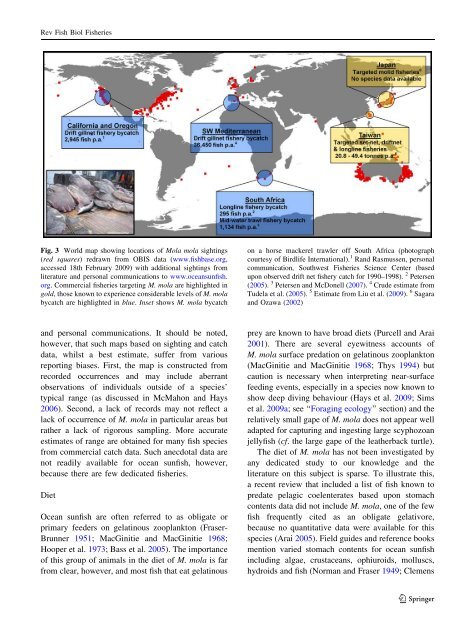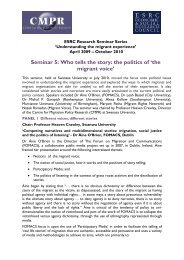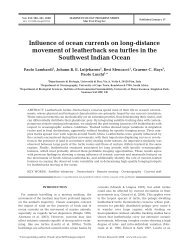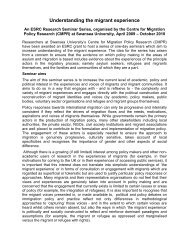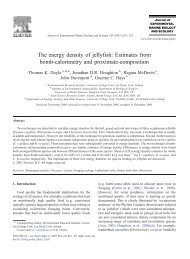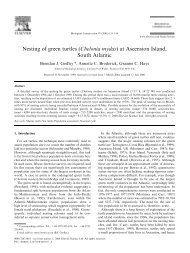The biology and ecology of the ocean sunfish - Swansea University
The biology and ecology of the ocean sunfish - Swansea University
The biology and ecology of the ocean sunfish - Swansea University
You also want an ePaper? Increase the reach of your titles
YUMPU automatically turns print PDFs into web optimized ePapers that Google loves.
Rev Fish Biol Fisheries<br />
Fig. 3 World map showing locations <strong>of</strong> Mola mola sightings<br />
(red squares) redrawn from OBIS data (www.fishbase.org,<br />
accessed 18th February 2009) with additional sightings from<br />
literature <strong>and</strong> personal communications to www.<strong>ocean</strong><strong>sunfish</strong>.<br />
org. Commercial fisheries targeting M. mola are highlighted in<br />
gold, those known to experience considerable levels <strong>of</strong> M. mola<br />
bycatch are highlighted in blue. Inset shows M. mola bycatch<br />
on a horse mackerel trawler <strong>of</strong>f South Africa (photograph<br />
courtesy <strong>of</strong> Birdlife International). 1 R<strong>and</strong> Rasmussen, personal<br />
communication, Southwest Fisheries Science Center (based<br />
upon observed drift net fishery catch for 1990–1998). 2 Petersen<br />
(2005). 3 Petersen <strong>and</strong> McDonell (2007). 4 Crude estimate from<br />
Tudela et al. (2005). 5 Estimate from Liu et al. (2009). 6 Sagara<br />
<strong>and</strong> Ozawa (2002)<br />
<strong>and</strong> personal communications. It should be noted,<br />
however, that such maps based on sighting <strong>and</strong> catch<br />
data, whilst a best estimate, suffer from various<br />
reporting biases. First, <strong>the</strong> map is constructed from<br />
recorded occurrences <strong>and</strong> may include aberrant<br />
observations <strong>of</strong> individuals outside <strong>of</strong> a species’<br />
typical range (as discussed in McMahon <strong>and</strong> Hays<br />
2006). Second, a lack <strong>of</strong> records may not reflect a<br />
lack <strong>of</strong> occurrence <strong>of</strong> M. mola in particular areas but<br />
ra<strong>the</strong>r a lack <strong>of</strong> rigorous sampling. More accurate<br />
estimates <strong>of</strong> range are obtained for many fish species<br />
from commercial catch data. Such anecdotal data are<br />
not readily available for <strong>ocean</strong> <strong>sunfish</strong>, however,<br />
because <strong>the</strong>re are few dedicated fisheries.<br />
Diet<br />
Ocean <strong>sunfish</strong> are <strong>of</strong>ten referred to as obligate or<br />
primary feeders on gelatinous zooplankton (Fraser-<br />
Brunner 1951; MacGinitie <strong>and</strong> MacGinitie 1968;<br />
Hooper et al. 1973; Bass et al. 2005). <strong>The</strong> importance<br />
<strong>of</strong> this group <strong>of</strong> animals in <strong>the</strong> diet <strong>of</strong> M. mola is far<br />
from clear, however, <strong>and</strong> most fish that eat gelatinous<br />
prey are known to have broad diets (Purcell <strong>and</strong> Arai<br />
2001). <strong>The</strong>re are several eyewitness accounts <strong>of</strong><br />
M. mola surface predation on gelatinous zooplankton<br />
(MacGinitie <strong>and</strong> MacGinitie 1968; Thys1994) but<br />
caution is necessary when interpreting near-surface<br />
feeding events, especially in a species now known to<br />
show deep diving behaviour (Hays et al. 2009; Sims<br />
et al. 2009a; see ‘‘Foraging <strong>ecology</strong>’’ section) <strong>and</strong> <strong>the</strong><br />
relatively small gape <strong>of</strong> M. mola does not appear well<br />
adapted for capturing <strong>and</strong> ingesting large scyphozoan<br />
jellyfish (cf. <strong>the</strong> large gape <strong>of</strong> <strong>the</strong> lea<strong>the</strong>rback turtle).<br />
<strong>The</strong> diet <strong>of</strong> M. mola has not been investigated by<br />
any dedicated study to our knowledge <strong>and</strong> <strong>the</strong><br />
literature on this subject is sparse. To illustrate this,<br />
a recent review that included a list <strong>of</strong> fish known to<br />
predate pelagic coelenterates based upon stomach<br />
contents data did not include M. mola, one <strong>of</strong> <strong>the</strong> few<br />
fish frequently cited as an obligate gelativore,<br />
because no quantitative data were available for this<br />
species (Arai 2005). Field guides <strong>and</strong> reference books<br />
mention varied stomach contents for <strong>ocean</strong> <strong>sunfish</strong><br />
including algae, crustaceans, ophiuroids, molluscs,<br />
hydroids <strong>and</strong> fish (Norman <strong>and</strong> Fraser 1949; Clemens<br />
123


